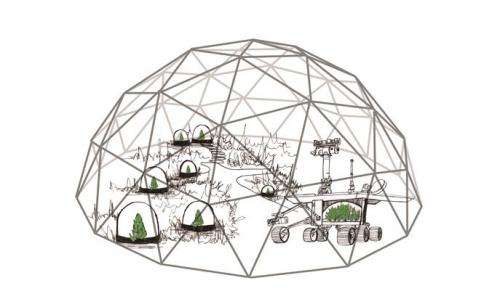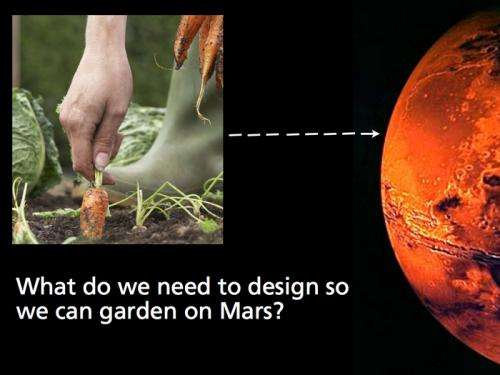How to plant a garden on Mars—with a robot

In the last century humanity has taken gigantic leaps forward in the robotic exploration of the cosmos—not least in the search for habitable worlds and environments that could house life outside of the Earth. The next logical step is for humanity itself to leave the confines of our planet, and take on long-term human exploration of the Solar System. Mars in particular is a key target for future human planetary adventures even though on the face of it, it seems so hostile to human life. In fact Mars actually has the most clement environment of any planet in the Solar System outside of Earth and is known to have all of the resources necessary in some accessible form, to sustain life on the surface. So how might we survive on Mars? The crucial things for humans on Mars are the availability of oxygen, shelter, food and water, and not just endless consumables delivered to the planet from Earth. For humans to live long-term on Mars, they will need a self-sustaining habitat to be able to thrive in for generations.
In short, they'll need a garden. And maybe a robot, too.
Any garden on Mars would need protection in the form of a greenhouse or geodesic dome that could keep the vegetables, fruits, grains and flowers sheltered from the extreme UV radiation that floods the Martian surface, whilst still allowing enough sunlight through to allow them to grow. This dome would also have to be strong enough to provide support and protection against potentially devastating Martian dust storms.
The crops would need to be kept warm, as outside the dome it will be on average a freezing -63 °C. Solar panels arranged outside the habitat and heating filaments underneath it could provide the desired warmth.
Liquid water is needed for irrigation of the plants and for future human consumption, but with water on Mars mainly frozen beneath the surface, we would need to mine the ice and melt it. The atmosphere on Mars is chiefly composed of CO2, which humans cannot use for any of our vital functions. However plants can! They can utilise this atmospheric CO2 to photosynthesise, which would actually create the oxygen we would need.
These are all important aspects of long-term human habitation of Mars that need to be tested and perfected before we arrive, but thankfully most of these can be investigated whilst safely here on the Earth in Mars analogue environments and specially designed spaces.

Our premise is that of a pioneer AstroGardening robot, designed and built by ourselves, to be sent to Mars to set up garden habitats in advance of the first human inhabitants. It will scatter 'seed pills' containing various seeds, clay and nutrients across the habitat and nurture the growing plants.
But before we actually go to Mars, we are working on an interactive 'Mars Garden' exhibit and AstroGardening Rover designed to educate and inspire.
Installation designer Vanessa Harden and I are building such a space; an interactive experience designed for museums and science centers to entertain and educate on the perils and benefits of gardening on Mars, the ways in which we need to design tools to do this, the plants that would best grow in Mars soil and the methods we might use to obtain liquid water.
Visitors to this Mars concept habitat will get to meet the AstroGardening robot himself and walk around a lush and tranquil Martian garden. They will also get to see the range of food stuffs that we can actually grow in the Martian soil such as asparagus, potatoes, sweet potatoes, radish, alfalfa, and mung bean.
Our aim for this exhibit is to communicate the science behind future human habitation of Mars, the effect we as humans can have on an environment, and the ethics and logistics of colonising other planets.
The exhibit has already been invited to tour around some of London's most celebrated and beautiful venues such as observatories and planetariums, museums and art galleries, schools and universities, before heading across the ocean to the US and Canada.
More information: www.kickstarter.com/projects/1 … ing-for-life-on-mars
Source: Universe Today





















